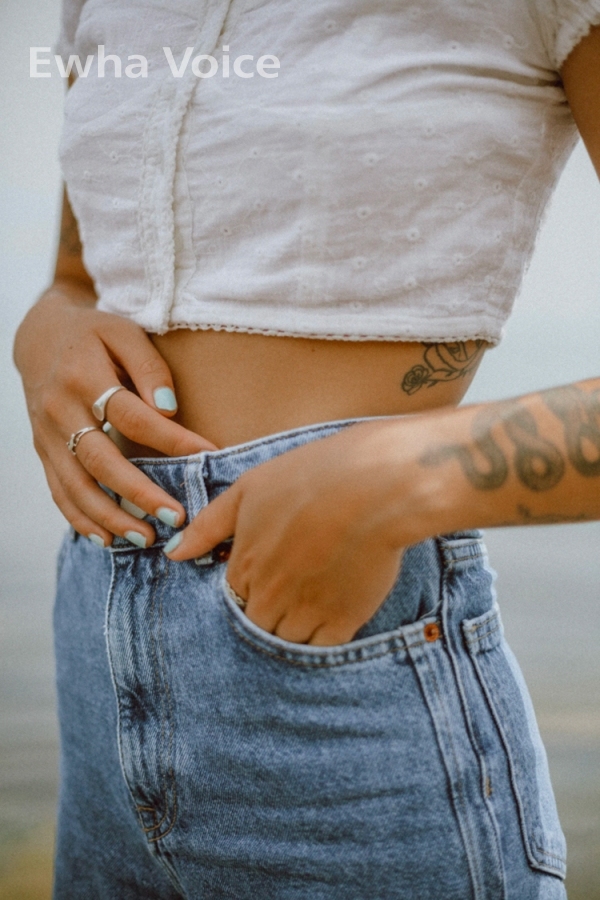
Fashion trends always seem to have a way of making a comeback, with Y2K being no exception. The iconic crop tops of Y2K fashion may not benew, but they are definitely dominating the streets nowadays.
According to a survey of 75 Ewha students conducted by Ewha Voice from Aug. 24 to Aug. 31, more than 90 percent of the respondents have noticed the current trend of crop tops.
However, the trend struck a sour note with some complaining about the sizes of clothing getting smaller and smaller along with these trends. One respondent from the survey claimed that, even though she has not gained weight, when she buys medium-sized clothes as she used to, they often do not fit anymore.
Professor Lee Jung-soo from the Department of Fashion Industry shared her insights on the way a trend is formed these days. Before the influx of social media, a few leading fashion companies played a pivotal role in setting new trends. They forecasted and suggested new styles of future fashion trends, with related textile industries keeping up with this prediction.
“These days, a trend is ‘created’ rather than built.” Lee said.
The fashion industry nowadays cannot help paying attention to social media reactions because they serve as an indication of the success or failure of the collection. The more a certain style receives love and support from the audience, the more it is exposed to the public and gains popularity.
“In following trends, the Korean market is never behind.” Lee added.
In addition, Lee pointed to fast fashion, the tendency to quickly replace clothes every new season, among the younger generation. With the increased use of online shopping malls and lower barriers to new trends compared to older generations, the younger generation is more likely to fill their wardrobes with trendy clothes.
According to the survey, 43 percent of the respondents agreed that they feel pressured to follow trends, and 21 percent replied that they follow trends without thinking, which shows how susceptible young people are.
Despite the trendiness of crop top fashion, some respondents expressed concerns about size availability. In fact, the size inclusivity issue in the fashion industry has been around for a long time. When asked about discomfort due to clothing sizes, students shared various opinions, but many pointed out the lack of variety in sizes, particularly due to standardized small sizes.
It is very common to see single-sized clothes in stores under the designation "free size." This is done by producers in order to minimize complication of the production process and maximize profits.
However, in reality, “free” sizes do not accommodate a wide range of buyers, mainly because free sizes are tailored to a skinny body figure.
“When the free size clothes do not fit my body, I feel like I am not the typical slim body figure,” said a respondent who wished to remain anonymous. “It makes me feel like I have to meet that standard, or else it is my fault or I am lazy.”
According to the investigation of the online stores of 15 major foreign and domestic SPA brands, domestic stores are significantly less diverse in size. In the case of ZARA and H&M, which are headquartered in Spain and Sweden respectively, most of the tops in their online shopping malls offered more than five sizes from XS to XL, or from 44 to 88.
On the other hand, domestic SPA brands such as 8seconds, SPAO, MIXXO and WHO.A.U had more clothes only available in free size, and if not, most came in two or three sizes.
“The high diversity in sizes in foreign countries is a reflection of societies composed of diverse races,” Lee said.
Still, the sizing system in Korea is standardized downward, not embracing various body figures.
If examined further, crop tops trace back to Western culture of the 1940s. In Korea, after the belly shirt boom in the 1990s, various styles of fashion circulated, and then short-length, tight cropped tops began to trend again in earnest from 2020.
In the survey, different opinions existed as to the current trend. Some respondents view it as a mere trend that people can readily turn away from. However, many shared concerns that this trend is emphasizing physical fitness more than before along with the strict body standard already existing in Korea. Also, some respondents criticized the public view on this trend, as some divide people by who can and cannot wear the trend with the fitness of the body.
As trends always come and go, judging a trend itself may be considered meaningless. However, it is important to contemplate the impact of the current fashion trend, considering how vulnerable younger generations are to trends and the atmosphere of our society that idealizes a slim body.

